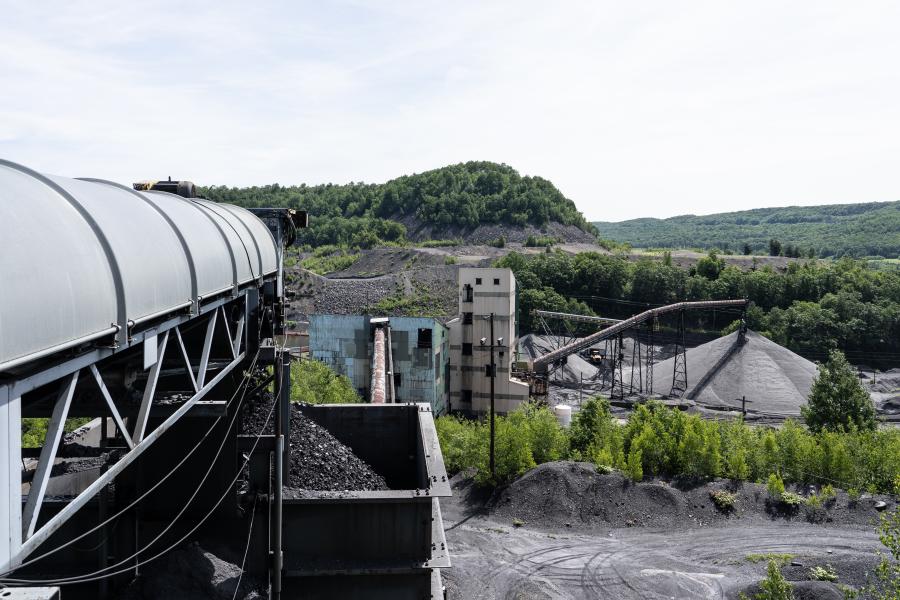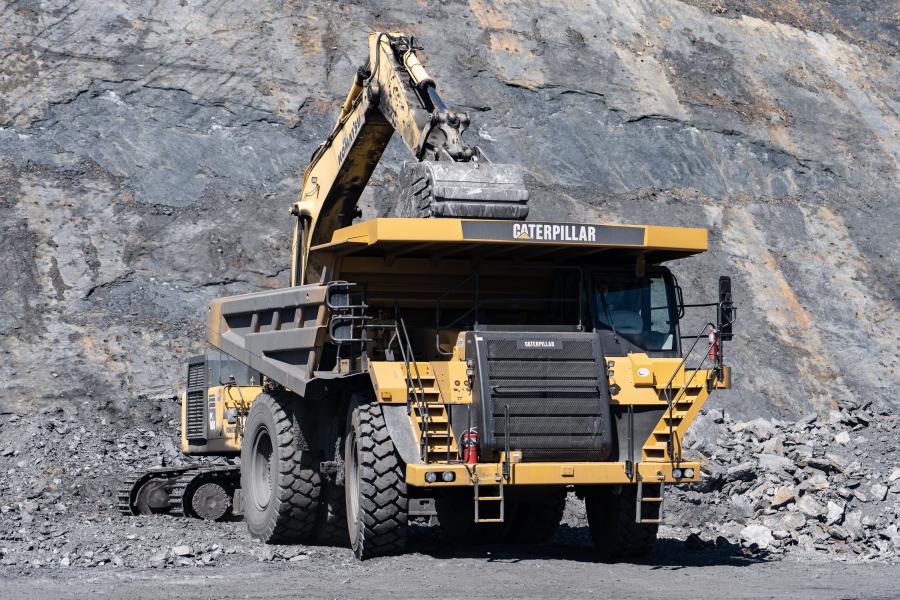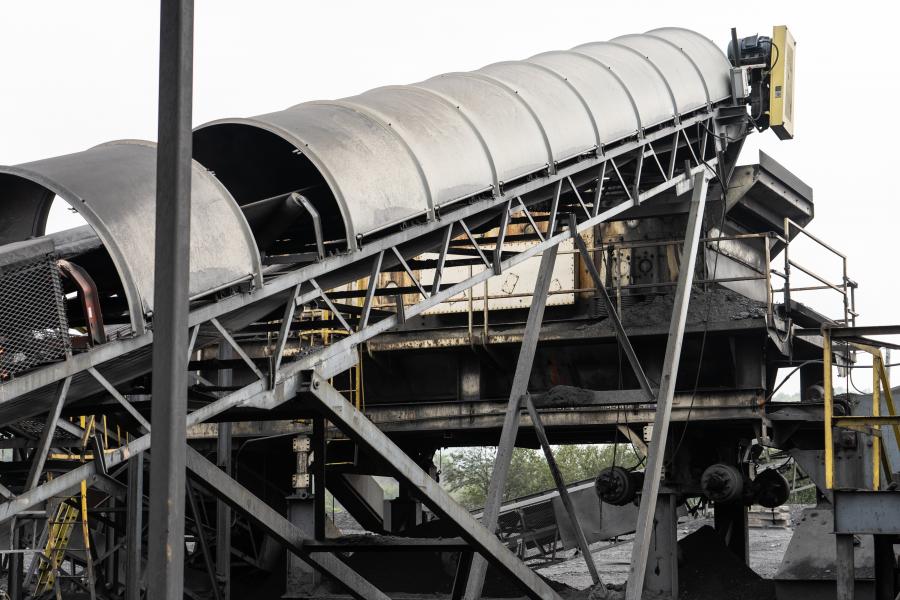The secondary crusher at Lehigh Anthracite’s raw stock pile/processing area.
(Editor's note: this is the final article of a three-part series that explores Lehigh Anthracite Coal LLC's operations in Pennsylvania. This article further details the equipment the company uses to bring its coal to the marketplace. To read part one click here. To read part two click here.)

Lehigh Anthracite Coal LLC operates an open pit mine on approximately 8,000 acres of land just outside of Tamaqua, Pa., in Schuylkill County. Lehigh Anthracite is the contract miner, employer and maintainer of all building assets on the property. There are 100 employees currently employed by the company. Lehigh Anthracite LP, a partnership between BET Associates IV LLC, and Robindale Energy & Associated Companies, owns all equipment on the property. BET Associates IV LLC is the mineral and land owner. BET Associates IV LLC's members are Bruce Toll and Douglas Topkis. Lehigh Anthracite currently operates two mine sites, which are Job 88 and Little Italy. Job 88 is closer to Tamaqua while Little Italy is closer to Nesquehoning, Pa.
Richard "Rusty" Taylor is the CEO of Lehigh Anthracite Coal LLC. Taylor is the former vice president of Environmental and Regulatory Matters at Robindale Energy & Associated Companies.
Hauling the Coal
In addition to its new Caterpillar 6015B hydraulic mining shovel, Lehigh Anthracite LP also purchased two Caterpillar 777F rigid frame haul trucks. The 777Fs were needed to help keep up with production since the new shovel was purchased. Lehigh Anthracite LP spent quite some time searching for two quality haul trucks to add to the fleet. (Lehigh has a fleet of multiple Caterpillar 777s, 775s 773s, Hitachi 1700-3s and miscellaneous Euclids.) The 777Fs are 2008 models and were purchased from Bill Miller Equipment Sales Inc., which is located in Eckhart Mines, Md.

Lehigh has dealt with Bill Miller in the past and has built a great relationship with the company. Miller's technicians rebuilt and repainted these two 777Fs in house. Once they were delivered to Lehigh's mine site, Miller's technicians assembled and tested them, making any necessary adjustments and fixes. The cab and chassis were delivered separately from the dump bodies because the latter required a super load permit to be moved. The 777F is powered by Cat C32 Acert 12-cylinder engine, which has a net horsepower rating of 939 hp. The truck has a top speed of 40 mph when loaded. The 777Fs have a 100-ton load capacity and weigh in around 180 tons when loaded. These two trucks are usually assigned to moving raw coal from the mine site to the stockpile/processing area.
Crushing Operations
After the raw coal is delivered to the stockpile/processing area, a loader takes the coal and feeds it into the crusher, closed loop, circuit. The primary and secondary crushers and the triple-deck horizontal screen in this circuit are used to make sure the coal is the correct top size to travel into the heavy media cyclone processing plant. The coal is separated from the rock and further screened into multiple sizes where it again travels to stockpiles via conveyor belts and chutes. From there, the coal travels to customers via on-road trucks and railroad cars (see Supplying the Coal Needs of the World.)

The on-road trucks are loaded by loaders and underneath the breaker, directly from bunkers. The rail cars are loaded via truck, loader and the breaker. (The heavy media cyclone processing plant/breaker is where the coal is separated from the rock and then screened into multiple different sizes before going into clean coal inventory.) The unit coal trains are moved to Baltimore, Md.; Pittsburgh, Pa.; and Fairless Hills, Pa., via the Reading & Northern Railroad (RBMN) and Norfolk Southern (NS).
The fine coal processing plant on the property deals with smaller pieces of coal, 2 mm to 100 mesh, which were once considered too small and discarded. This fine coal, silt, or slurry, is found all across the property in pockets after the previous mining companies buried it. A dozer and a loader are assigned to remove and feed the coal into the fine coal processing plant. This coal is screened into smaller, more fine pieces where it is then sent out to stockpiles via conveyor belts. This coal is used as a filter media for municipal water plants and also as a source of carbon in various metal recycling processes.
Supplying the Coal Needs of the World
Lehigh Anthracite Coal produces a wide array of coal products from its mines in Tamaqua and Nesquehoning, Pa. These finished products include:
- Egg/Stove, which is 3 ¼-in. x 1 9/16 in. This is used as a carbon additive in electric arc furnaces (EAF), as well as a heat source in the sugar beet process, and as a radiant heat source in pizza ovens;
- Nut, which is 1 9/16-in. x 13/16-in. This also is used in EAFs and is a very popular size for home heating;
- Pea, which is 13/16-in. x 9/16-in. This is another size popular for use in EAFs and sometimes home heating;
- Buck, which is 9/16-in. x 7/16-in. This particular size is ground into a paste that is then made into high voltage electrodes for EAFs. This also is a source of heat for large greenhouses;
- Rice, which is 7/16-in. x 3/16-in. and is very popular for home heating;
- Barley, which is 3/16-in. x 3/32-in. This is used in carbon injection in EAFs to create an insulating blanket on top of the liquid metal in a kettle;
- #4, which is 3/32-in. x 3/64-in. This is used as a filter media (along with sand) in municipal water treatment plants; and
- #5, which is 1 mm x 100 mesh. This also is used in carbon injection for EAF, water filtration and as an ingredient in charcoal briquettes.
CEG
Today's top stories
























